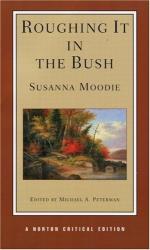I had my fears for poor John; but as the chance that he had to wait at the mill till others were served was more than probable, I tried to still my apprehensions for his safety.
The storm soon passed over, after having levelled several acres of wood near the house and smitten down in its progress two gigantic pines in the clearing, which must have withstood the force of a thousand winters. Talking over the effects of this whirlwind with my brother, he kindly sent me the following very graphic description of a whirlwind which passed the town of Guelph in the summer of 1829.
[Written by Mr. Strickland, of Douro.] “In my hunting excursions and rambles through the Upper Canadian forests, I had frequently met with extensive wind-falls; and observed with some surprise that the fallen trees lay strewn in a succession of circles, and evidently appeared to have been twisted off the stumps. I also remarked that these wind-falls were generally narrow, and had the appearance of a road, slashed through the forest. From observations made at the time, and since confirmed, I have no doubt that Colonel Reid’s theory of storms is the correct one, viz., that all wind-storms move in a circular direction, and the nearer the centre the more violent the force of the wind. Having seen the effects of several similar hurricanes since my residence in Canada West, I shall proceed to describe one which happened in the township of Guelph during the early part of the summer of 1829.
“The weather, for the season of the year (May), had been hot and sultry, with scarcely a breath of wind stirring. I had heard distant thunder from an early hour in the morning, which, from the eastward, is rather an unusual occurrence. About 10 A.M., the sky had a most singular, and I must add a most awful appearance, presenting to the view a vast arch of rolling blackness, which seemed to gather strength and density as it approached the zenith. All at once the clouds began to work round in circles, as if chasing one another through the air. Suddenly the dark arch of clouds appeared to break up into detached masses, whirling and mixing through each other in dreadful commotion. The forked lightning was incessant, accompanied by heavy thunder. In a short time, the clouds seemed to converge to a point, which approached very near the earth, still whirling with great rapidity directly under this point; and apparently from the midst of the woods arose a black column, in the shape of a cone, which instantly joined itself to the depending cloud. The sight was now grand, and awful in the extreme. Picture to your imagination a vast column of smoke, of inky blackness, reaching from the earth to heaven, gyrating with fearful velocity—bright lightnings issuing from the vortex—the roar of the thunder—the rushing of the blast—the crash of timber—the limbs of trees, leaves and rubbish, mingled with clouds of dust, whirling through the air;—you then have a faint idea of the scene.




